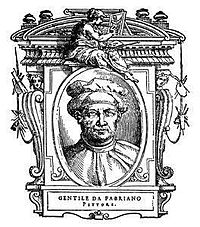Bazaar to Piazza Islamic Trade and Italian Art
| Gentile da Fabriano | |
|---|---|
 Gentile da Fabriano, in a portrait past Giorgio Vasari | |
| Born | Gentile di Nicolò di Giovanni c. 1370 Fabriano, Papal States |
| Died | 1427(1427-00-00) (aged 56–57) Rome, Papal States |
| Nationality | Italian |
| Known for | Painting |
| Notable work | Admiration of the Magi |
| Movement | International Gothic |
Gentile da Fabriano [a] (c. 1370 – 1427) was an Italian painter known for his participation in the International Gothic painter manner. He worked in various places in central Italy, by and large in Tuscany. His all-time-known works are his Adoration of the Magi from the Strozzi Altarpiece (1423), and the Flight into Egypt. Following a visit to Florence in the 1419, he came in contact with humanism, a fashion of art that he carried throughout the rest of his career.[iv] He became highly influential for other painters in Florence, peculiarly because of his use of detail based on the observations he made of the natural world.[5]
Life and career [edit]

Adoration of the Magi (1423)
Gentile was born in or near Fabriano, in the Marche. His female parent died some time before 1380, and his father, Niccolò di Giovanni Massi, retired to a monastery in the same year, where he died in 1385.[six] Little is known of his formation: 1 of his first known works, a Madonna and Child (c. 1395–1400, now in Berlin) shows the influence of the northern Italian late-Gothic painting.[seven] [8]
By around 1405, Gentile da Fabriano was working in Venice.[4] He painted a console for the church of Santa Sofia, now lost; Jacopo Bellini worked peradventure in his workshop. Between 1408 and 1409, he painted a fresco (now lost) in the Doge's Palace depicting the naval battle between the Venetians and Otto Iii. In Venice he knew Pisanello and maybe Michelino da Besozzo.[4] He also produced commissions for other cities during this menstruum, such as his Madonna and Kid for a church in Perugia.
In 1410–1412 he painted i of his first masterworks, the Valle Romita Polyptych (now at the Pinacoteca di Brera). In 1410–1411 he was at Foligno, where he frescoed the Palazzo Trinci. In 1414 he moved to Brescia, at the service of Pandolfo III Malatesta, and painted the Broletto Chapel, a piece of work now more often than not lost. In the Leap 1420 he was again in Fabriano.
Florence [edit]

On 6 August 1420 he was in Florence,[4] where he painted his famous altarpiece depicting the Adoration of the Magi (1423), commissioned by Palla Strozzi.[9] Which is at present in the Uffizi and regarded as one of the masterpieces of the International Gothic fashion. His other works in Florence include the Quaratesi Polyptych (May 1425) and the Intercession Altarpiece. In June–August 1425 he was in Siena, where he painted a Madonna with Kid, now lost, for the Palazzo dei Notai on Piazza del Campo. Until October he was in Orvieto, where he painted his fresco of the Madonna and Child in the Cathedral. In 1427 he arrived in Rome, deputed by Pope Martin V to decorate the nave of the Basilica of St. John in Lateran, which was completed by Pisanello afterwards his decease.
Gentile is known to have died before 14 October 1427. He is commonly said to accept been buried in the church now called S. Francesca Romana in Florence, but his tomb vanished; there is evidence, notwithstanding, that he may be buried in the church of Santa Maria in Trastevere, in Rome, the place of his expiry.
He left no works in the Marche, except perhaps a Madonna and Child (of uncertain attribution) in the Duomo at Sant'Angelo in Vado, near Urbino. He also left one painting in Venice.
Notes [edit]
- ^ Pronunciation: , ,[one] [2] [3] Italian: [dʒenˈtiːle da (f)fabriˈaːno].
References [edit]
- ^ "Gentile da Fabriano" (Us) and "Gentile da Fabriano". Oxford Dictionaries UK English language Dictionary. Oxford University Press. n.d. Retrieved one June 2019.
- ^ "Gentile da Fabriano". The American Heritage Dictionary of the English language Language (5th ed.). HarperCollins. Retrieved 1 June 2019.
- ^ "Gentile da Fabriano". Merriam-Webster Dictionary . Retrieved i June 2019.
- ^ a b c d "English Summary". Artibus et Historiae. 4 (8): 167–68. 1983.
- ^ "Gentile da Fabriano".
- ^ Wohl, Hellmut (2003). "Gentile (di Niccoló di Massio) da Fabriano".
- ^ "Biographie et œuvre de Gentile da Fabriano (five. 1370-1427)". www.rivagedeboheme.fr (in French). Retrieved 15 January 2022.
- ^ Vasari, Giorgio (2008). Lives of the Most Eminent Painters Sculptors & Architects. London: Philip Lee Warner. pp. 107–117.
- ^ Mack, Rosamond E. Boutique to Piazza: Islamic Merchandise and Italian Art, 1300-1600. University of California Printing. p. 65. ISBN0520221311.
Sources [edit]
- Mack, Rosamond E. (2001). Bazaar to Piazza: Islamic Trade and Italian Fine art, 1300–1600. Academy of California Press. ISBN0-520-22131-1.
- Gentile da Fabriano eastward l'altro Rinascimento, catalogo della mostra (in Italian). Fabriano: Electa. 2006. Exposition lasting 21 Apr–23 July 2006.
- Marcelli, Fabio (2005). Gentile da Fabriano (in Italian). Silvana.
- De Marchi, Andrea (1992). Gentile da Fabriano. Un viaggio nella pittura italiana alla fine del gotico (in Italian). Federico Motta (published 2006).
- Łada, Justyna (2004). Obraz Maryi z Dzieciątkiem Gentile da Fabriano jako przykład typu Madonny (in Smoothen). Roczniki Humanistyczne KUL.
External links [edit]
- Gentile da Fabriano biography-paintings-curiosity-publications
- Italian Paintings: Sienese and Cardinal Italian Schools, a collection catalog containing data about Fabriano and his works (run across index; plates 34-35).
- 5 paintings of Gentile da Fabriano
- Gentile da Fabriano at the National Gallery of Art, Washington DC
Source: https://en.wikipedia.org/wiki/Gentile_da_Fabriano
0 Response to "Bazaar to Piazza Islamic Trade and Italian Art"
Post a Comment